Contemporary Management: Analysis of Case Studies and Elevator Pitches
VerifiedAdded on 2021/05/31
|11
|2921
|604
Report
AI Summary
This report analyzes several aspects of contemporary management, including the importance of planning, organizational culture, and responses to case studies. The report explores the significance of planning in achieving goals, emphasizing its role in project and time management. It also discusses the impact of organizational culture on employee interaction and motivation, referencing relevant literature. Furthermore, the report presents responses to case studies, addressing management problems faced by Benjys, Typware, Parivar, and Cheryl Hailstrom. The analysis covers strategic dilemmas, compensation issues, organizational structure, and the challenges of change management, providing insights into leadership and organizational challenges.
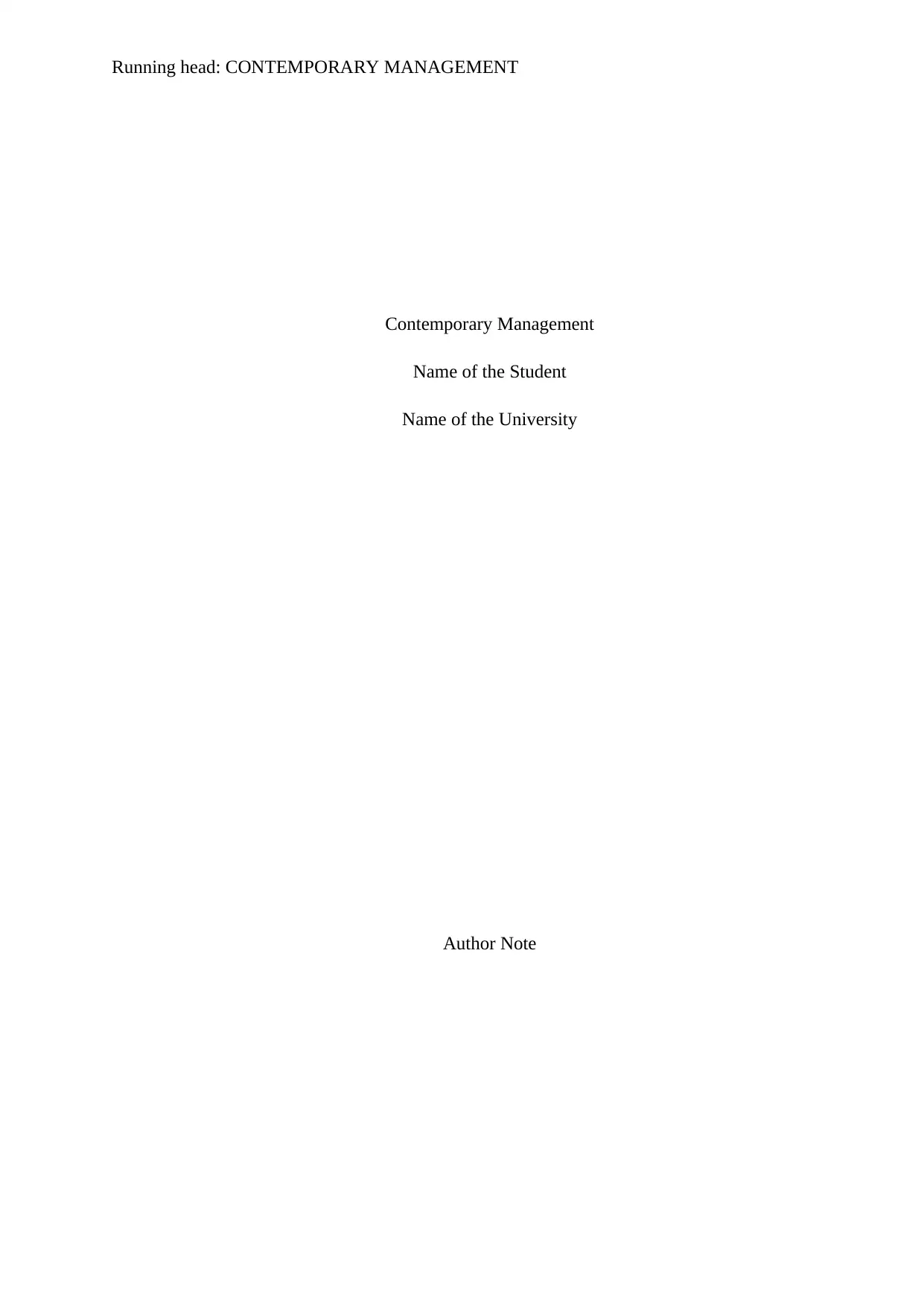
Running head: CONTEMPORARY MANAGEMENT
Contemporary Management
Name of the Student
Name of the University
Author Note
Contemporary Management
Name of the Student
Name of the University
Author Note
Paraphrase This Document
Need a fresh take? Get an instant paraphrase of this document with our AI Paraphraser
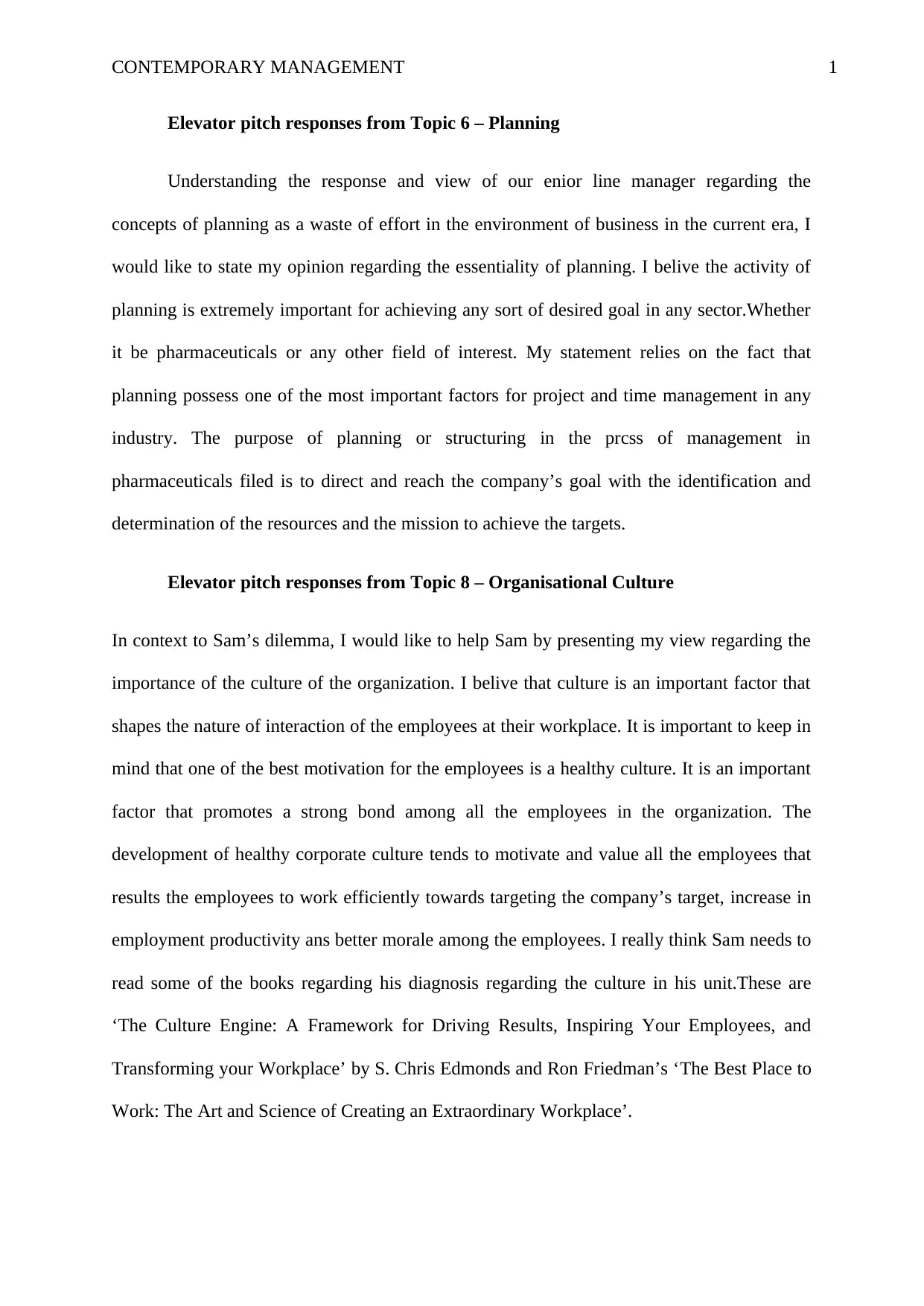
CONTEMPORARY MANAGEMENT 1
Elevator pitch responses from Topic 6 – Planning
Understanding the response and view of our enior line manager regarding the
concepts of planning as a waste of effort in the environment of business in the current era, I
would like to state my opinion regarding the essentiality of planning. I belive the activity of
planning is extremely important for achieving any sort of desired goal in any sector.Whether
it be pharmaceuticals or any other field of interest. My statement relies on the fact that
planning possess one of the most important factors for project and time management in any
industry. The purpose of planning or structuring in the prcss of management in
pharmaceuticals filed is to direct and reach the company’s goal with the identification and
determination of the resources and the mission to achieve the targets.
Elevator pitch responses from Topic 8 – Organisational Culture
In context to Sam’s dilemma, I would like to help Sam by presenting my view regarding the
importance of the culture of the organization. I belive that culture is an important factor that
shapes the nature of interaction of the employees at their workplace. It is important to keep in
mind that one of the best motivation for the employees is a healthy culture. It is an important
factor that promotes a strong bond among all the employees in the organization. The
development of healthy corporate culture tends to motivate and value all the employees that
results the employees to work efficiently towards targeting the company’s target, increase in
employment productivity ans better morale among the employees. I really think Sam needs to
read some of the books regarding his diagnosis regarding the culture in his unit.These are
‘The Culture Engine: A Framework for Driving Results, Inspiring Your Employees, and
Transforming your Workplace’ by S. Chris Edmonds and Ron Friedman’s ‘The Best Place to
Work: The Art and Science of Creating an Extraordinary Workplace’.
Elevator pitch responses from Topic 6 – Planning
Understanding the response and view of our enior line manager regarding the
concepts of planning as a waste of effort in the environment of business in the current era, I
would like to state my opinion regarding the essentiality of planning. I belive the activity of
planning is extremely important for achieving any sort of desired goal in any sector.Whether
it be pharmaceuticals or any other field of interest. My statement relies on the fact that
planning possess one of the most important factors for project and time management in any
industry. The purpose of planning or structuring in the prcss of management in
pharmaceuticals filed is to direct and reach the company’s goal with the identification and
determination of the resources and the mission to achieve the targets.
Elevator pitch responses from Topic 8 – Organisational Culture
In context to Sam’s dilemma, I would like to help Sam by presenting my view regarding the
importance of the culture of the organization. I belive that culture is an important factor that
shapes the nature of interaction of the employees at their workplace. It is important to keep in
mind that one of the best motivation for the employees is a healthy culture. It is an important
factor that promotes a strong bond among all the employees in the organization. The
development of healthy corporate culture tends to motivate and value all the employees that
results the employees to work efficiently towards targeting the company’s target, increase in
employment productivity ans better morale among the employees. I really think Sam needs to
read some of the books regarding his diagnosis regarding the culture in his unit.These are
‘The Culture Engine: A Framework for Driving Results, Inspiring Your Employees, and
Transforming your Workplace’ by S. Chris Edmonds and Ron Friedman’s ‘The Best Place to
Work: The Art and Science of Creating an Extraordinary Workplace’.
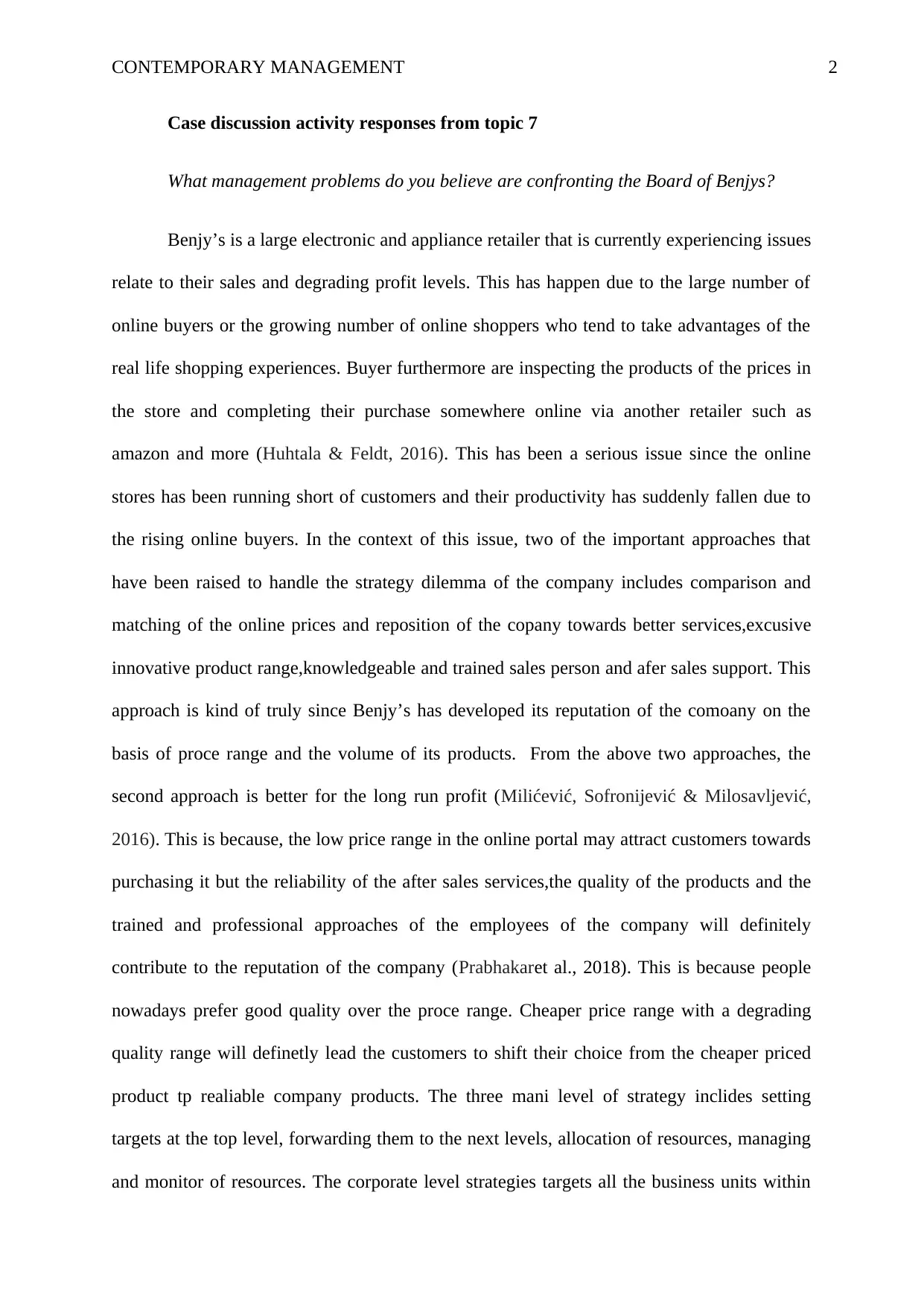
CONTEMPORARY MANAGEMENT 2
Case discussion activity responses from topic 7
What management problems do you believe are confronting the Board of Benjys?
Benjy’s is a large electronic and appliance retailer that is currently experiencing issues
relate to their sales and degrading profit levels. This has happen due to the large number of
online buyers or the growing number of online shoppers who tend to take advantages of the
real life shopping experiences. Buyer furthermore are inspecting the products of the prices in
the store and completing their purchase somewhere online via another retailer such as
amazon and more (Huhtala & Feldt, 2016). This has been a serious issue since the online
stores has been running short of customers and their productivity has suddenly fallen due to
the rising online buyers. In the context of this issue, two of the important approaches that
have been raised to handle the strategy dilemma of the company includes comparison and
matching of the online prices and reposition of the copany towards better services,excusive
innovative product range,knowledgeable and trained sales person and afer sales support. This
approach is kind of truly since Benjy’s has developed its reputation of the comoany on the
basis of proce range and the volume of its products. From the above two approaches, the
second approach is better for the long run profit (Milićević, Sofronijević & Milosavljević,
2016). This is because, the low price range in the online portal may attract customers towards
purchasing it but the reliability of the after sales services,the quality of the products and the
trained and professional approaches of the employees of the company will definitely
contribute to the reputation of the company (Prabhakaret al., 2018). This is because people
nowadays prefer good quality over the proce range. Cheaper price range with a degrading
quality range will definetly lead the customers to shift their choice from the cheaper priced
product tp realiable company products. The three mani level of strategy inclides setting
targets at the top level, forwarding them to the next levels, allocation of resources, managing
and monitor of resources. The corporate level strategies targets all the business units within
Case discussion activity responses from topic 7
What management problems do you believe are confronting the Board of Benjys?
Benjy’s is a large electronic and appliance retailer that is currently experiencing issues
relate to their sales and degrading profit levels. This has happen due to the large number of
online buyers or the growing number of online shoppers who tend to take advantages of the
real life shopping experiences. Buyer furthermore are inspecting the products of the prices in
the store and completing their purchase somewhere online via another retailer such as
amazon and more (Huhtala & Feldt, 2016). This has been a serious issue since the online
stores has been running short of customers and their productivity has suddenly fallen due to
the rising online buyers. In the context of this issue, two of the important approaches that
have been raised to handle the strategy dilemma of the company includes comparison and
matching of the online prices and reposition of the copany towards better services,excusive
innovative product range,knowledgeable and trained sales person and afer sales support. This
approach is kind of truly since Benjy’s has developed its reputation of the comoany on the
basis of proce range and the volume of its products. From the above two approaches, the
second approach is better for the long run profit (Milićević, Sofronijević & Milosavljević,
2016). This is because, the low price range in the online portal may attract customers towards
purchasing it but the reliability of the after sales services,the quality of the products and the
trained and professional approaches of the employees of the company will definitely
contribute to the reputation of the company (Prabhakaret al., 2018). This is because people
nowadays prefer good quality over the proce range. Cheaper price range with a degrading
quality range will definetly lead the customers to shift their choice from the cheaper priced
product tp realiable company products. The three mani level of strategy inclides setting
targets at the top level, forwarding them to the next levels, allocation of resources, managing
and monitor of resources. The corporate level strategies targets all the business units within
⊘ This is a preview!⊘
Do you want full access?
Subscribe today to unlock all pages.

Trusted by 1+ million students worldwide
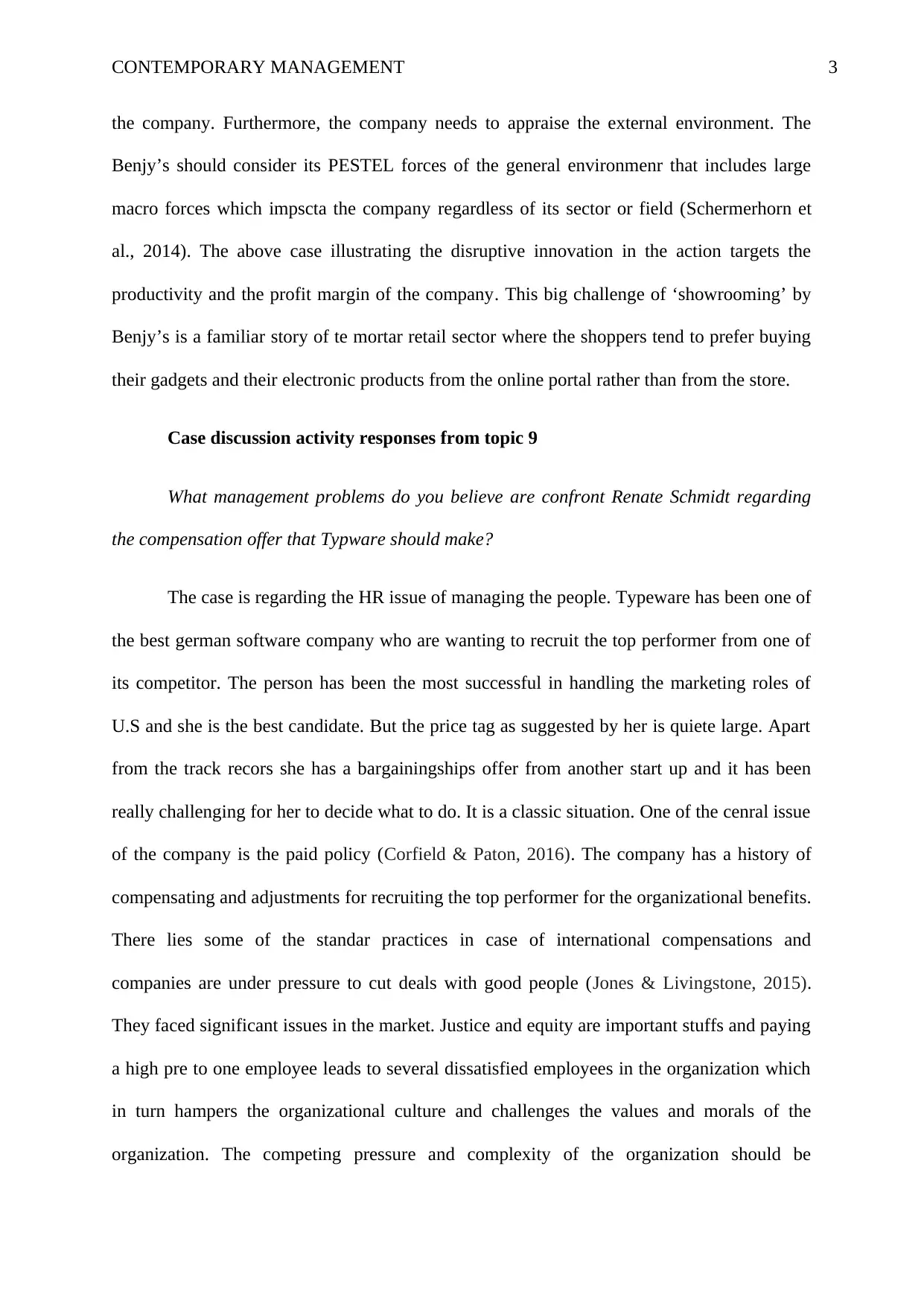
CONTEMPORARY MANAGEMENT 3
the company. Furthermore, the company needs to appraise the external environment. The
Benjy’s should consider its PESTEL forces of the general environmenr that includes large
macro forces which impscta the company regardless of its sector or field (Schermerhorn et
al., 2014). The above case illustrating the disruptive innovation in the action targets the
productivity and the profit margin of the company. This big challenge of ‘showrooming’ by
Benjy’s is a familiar story of te mortar retail sector where the shoppers tend to prefer buying
their gadgets and their electronic products from the online portal rather than from the store.
Case discussion activity responses from topic 9
What management problems do you believe are confront Renate Schmidt regarding
the compensation offer that Typware should make?
The case is regarding the HR issue of managing the people. Typeware has been one of
the best german software company who are wanting to recruit the top performer from one of
its competitor. The person has been the most successful in handling the marketing roles of
U.S and she is the best candidate. But the price tag as suggested by her is quiete large. Apart
from the track recors she has a bargainingships offer from another start up and it has been
really challenging for her to decide what to do. It is a classic situation. One of the cenral issue
of the company is the paid policy (Corfield & Paton, 2016). The company has a history of
compensating and adjustments for recruiting the top performer for the organizational benefits.
There lies some of the standar practices in case of international compensations and
companies are under pressure to cut deals with good people (Jones & Livingstone, 2015).
They faced significant issues in the market. Justice and equity are important stuffs and paying
a high pre to one employee leads to several dissatisfied employees in the organization which
in turn hampers the organizational culture and challenges the values and morals of the
organization. The competing pressure and complexity of the organization should be
the company. Furthermore, the company needs to appraise the external environment. The
Benjy’s should consider its PESTEL forces of the general environmenr that includes large
macro forces which impscta the company regardless of its sector or field (Schermerhorn et
al., 2014). The above case illustrating the disruptive innovation in the action targets the
productivity and the profit margin of the company. This big challenge of ‘showrooming’ by
Benjy’s is a familiar story of te mortar retail sector where the shoppers tend to prefer buying
their gadgets and their electronic products from the online portal rather than from the store.
Case discussion activity responses from topic 9
What management problems do you believe are confront Renate Schmidt regarding
the compensation offer that Typware should make?
The case is regarding the HR issue of managing the people. Typeware has been one of
the best german software company who are wanting to recruit the top performer from one of
its competitor. The person has been the most successful in handling the marketing roles of
U.S and she is the best candidate. But the price tag as suggested by her is quiete large. Apart
from the track recors she has a bargainingships offer from another start up and it has been
really challenging for her to decide what to do. It is a classic situation. One of the cenral issue
of the company is the paid policy (Corfield & Paton, 2016). The company has a history of
compensating and adjustments for recruiting the top performer for the organizational benefits.
There lies some of the standar practices in case of international compensations and
companies are under pressure to cut deals with good people (Jones & Livingstone, 2015).
They faced significant issues in the market. Justice and equity are important stuffs and paying
a high pre to one employee leads to several dissatisfied employees in the organization which
in turn hampers the organizational culture and challenges the values and morals of the
organization. The competing pressure and complexity of the organization should be
Paraphrase This Document
Need a fresh take? Get an instant paraphrase of this document with our AI Paraphraser
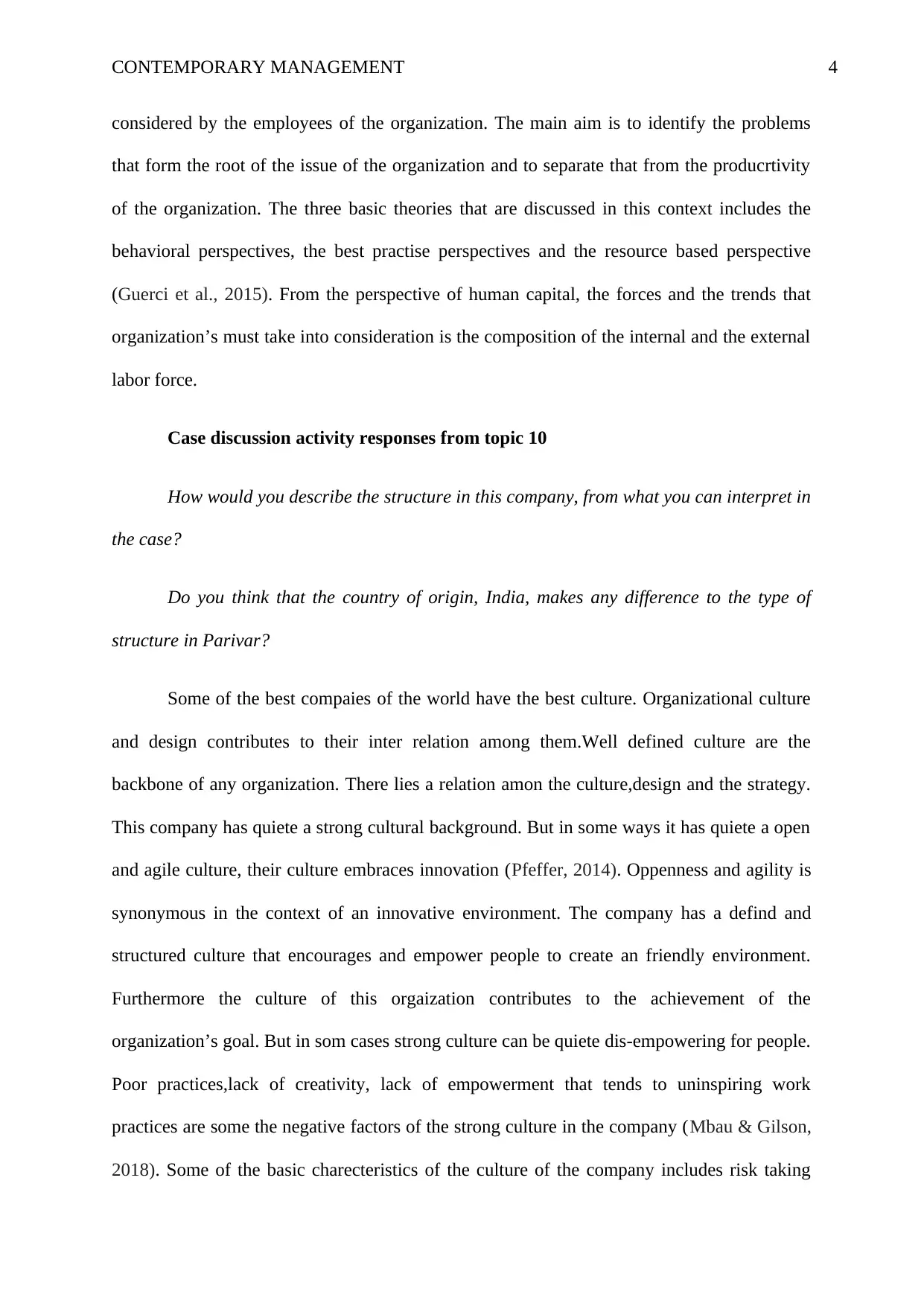
CONTEMPORARY MANAGEMENT 4
considered by the employees of the organization. The main aim is to identify the problems
that form the root of the issue of the organization and to separate that from the producrtivity
of the organization. The three basic theories that are discussed in this context includes the
behavioral perspectives, the best practise perspectives and the resource based perspective
(Guerci et al., 2015). From the perspective of human capital, the forces and the trends that
organization’s must take into consideration is the composition of the internal and the external
labor force.
Case discussion activity responses from topic 10
How would you describe the structure in this company, from what you can interpret in
the case?
Do you think that the country of origin, India, makes any difference to the type of
structure in Parivar?
Some of the best compaies of the world have the best culture. Organizational culture
and design contributes to their inter relation among them.Well defined culture are the
backbone of any organization. There lies a relation amon the culture,design and the strategy.
This company has quiete a strong cultural background. But in some ways it has quiete a open
and agile culture, their culture embraces innovation (Pfeffer, 2014). Oppenness and agility is
synonymous in the context of an innovative environment. The company has a defind and
structured culture that encourages and empower people to create an friendly environment.
Furthermore the culture of this orgaization contributes to the achievement of the
organization’s goal. But in som cases strong culture can be quiete dis-empowering for people.
Poor practices,lack of creativity, lack of empowerment that tends to uninspiring work
practices are some the negative factors of the strong culture in the company (Mbau & Gilson,
2018). Some of the basic charecteristics of the culture of the company includes risk taking
considered by the employees of the organization. The main aim is to identify the problems
that form the root of the issue of the organization and to separate that from the producrtivity
of the organization. The three basic theories that are discussed in this context includes the
behavioral perspectives, the best practise perspectives and the resource based perspective
(Guerci et al., 2015). From the perspective of human capital, the forces and the trends that
organization’s must take into consideration is the composition of the internal and the external
labor force.
Case discussion activity responses from topic 10
How would you describe the structure in this company, from what you can interpret in
the case?
Do you think that the country of origin, India, makes any difference to the type of
structure in Parivar?
Some of the best compaies of the world have the best culture. Organizational culture
and design contributes to their inter relation among them.Well defined culture are the
backbone of any organization. There lies a relation amon the culture,design and the strategy.
This company has quiete a strong cultural background. But in some ways it has quiete a open
and agile culture, their culture embraces innovation (Pfeffer, 2014). Oppenness and agility is
synonymous in the context of an innovative environment. The company has a defind and
structured culture that encourages and empower people to create an friendly environment.
Furthermore the culture of this orgaization contributes to the achievement of the
organization’s goal. But in som cases strong culture can be quiete dis-empowering for people.
Poor practices,lack of creativity, lack of empowerment that tends to uninspiring work
practices are some the negative factors of the strong culture in the company (Mbau & Gilson,
2018). Some of the basic charecteristics of the culture of the company includes risk taking
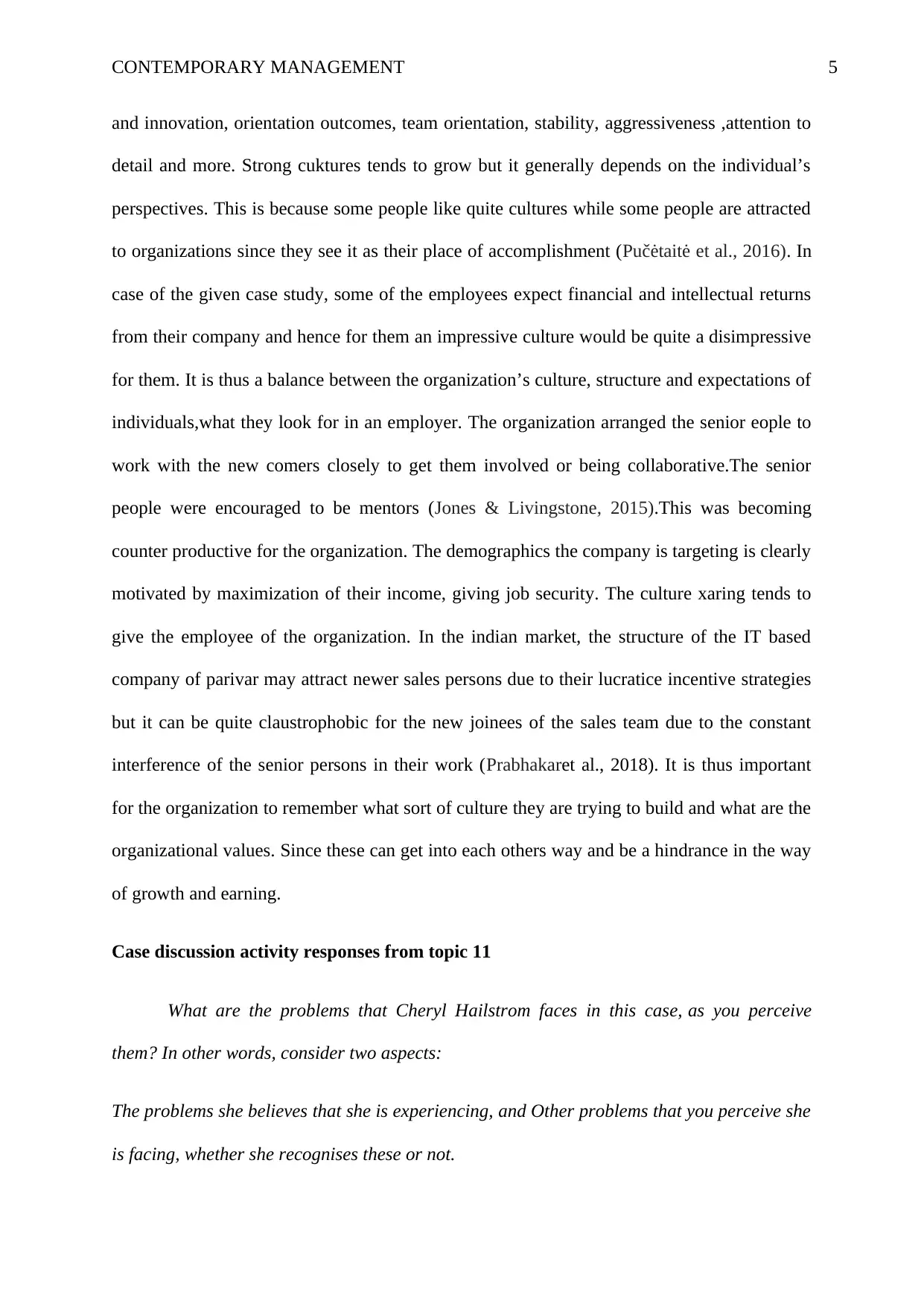
CONTEMPORARY MANAGEMENT 5
and innovation, orientation outcomes, team orientation, stability, aggressiveness ,attention to
detail and more. Strong cuktures tends to grow but it generally depends on the individual’s
perspectives. This is because some people like quite cultures while some people are attracted
to organizations since they see it as their place of accomplishment (Pučėtaitė et al., 2016). In
case of the given case study, some of the employees expect financial and intellectual returns
from their company and hence for them an impressive culture would be quite a disimpressive
for them. It is thus a balance between the organization’s culture, structure and expectations of
individuals,what they look for in an employer. The organization arranged the senior eople to
work with the new comers closely to get them involved or being collaborative.The senior
people were encouraged to be mentors (Jones & Livingstone, 2015).This was becoming
counter productive for the organization. The demographics the company is targeting is clearly
motivated by maximization of their income, giving job security. The culture xaring tends to
give the employee of the organization. In the indian market, the structure of the IT based
company of parivar may attract newer sales persons due to their lucratice incentive strategies
but it can be quite claustrophobic for the new joinees of the sales team due to the constant
interference of the senior persons in their work (Prabhakaret al., 2018). It is thus important
for the organization to remember what sort of culture they are trying to build and what are the
organizational values. Since these can get into each others way and be a hindrance in the way
of growth and earning.
Case discussion activity responses from topic 11
What are the problems that Cheryl Hailstrom faces in this case, as you perceive
them? In other words, consider two aspects:
The problems she believes that she is experiencing, and Other problems that you perceive she
is facing, whether she recognises these or not.
and innovation, orientation outcomes, team orientation, stability, aggressiveness ,attention to
detail and more. Strong cuktures tends to grow but it generally depends on the individual’s
perspectives. This is because some people like quite cultures while some people are attracted
to organizations since they see it as their place of accomplishment (Pučėtaitė et al., 2016). In
case of the given case study, some of the employees expect financial and intellectual returns
from their company and hence for them an impressive culture would be quite a disimpressive
for them. It is thus a balance between the organization’s culture, structure and expectations of
individuals,what they look for in an employer. The organization arranged the senior eople to
work with the new comers closely to get them involved or being collaborative.The senior
people were encouraged to be mentors (Jones & Livingstone, 2015).This was becoming
counter productive for the organization. The demographics the company is targeting is clearly
motivated by maximization of their income, giving job security. The culture xaring tends to
give the employee of the organization. In the indian market, the structure of the IT based
company of parivar may attract newer sales persons due to their lucratice incentive strategies
but it can be quite claustrophobic for the new joinees of the sales team due to the constant
interference of the senior persons in their work (Prabhakaret al., 2018). It is thus important
for the organization to remember what sort of culture they are trying to build and what are the
organizational values. Since these can get into each others way and be a hindrance in the way
of growth and earning.
Case discussion activity responses from topic 11
What are the problems that Cheryl Hailstrom faces in this case, as you perceive
them? In other words, consider two aspects:
The problems she believes that she is experiencing, and Other problems that you perceive she
is facing, whether she recognises these or not.
⊘ This is a preview!⊘
Do you want full access?
Subscribe today to unlock all pages.

Trusted by 1+ million students worldwide
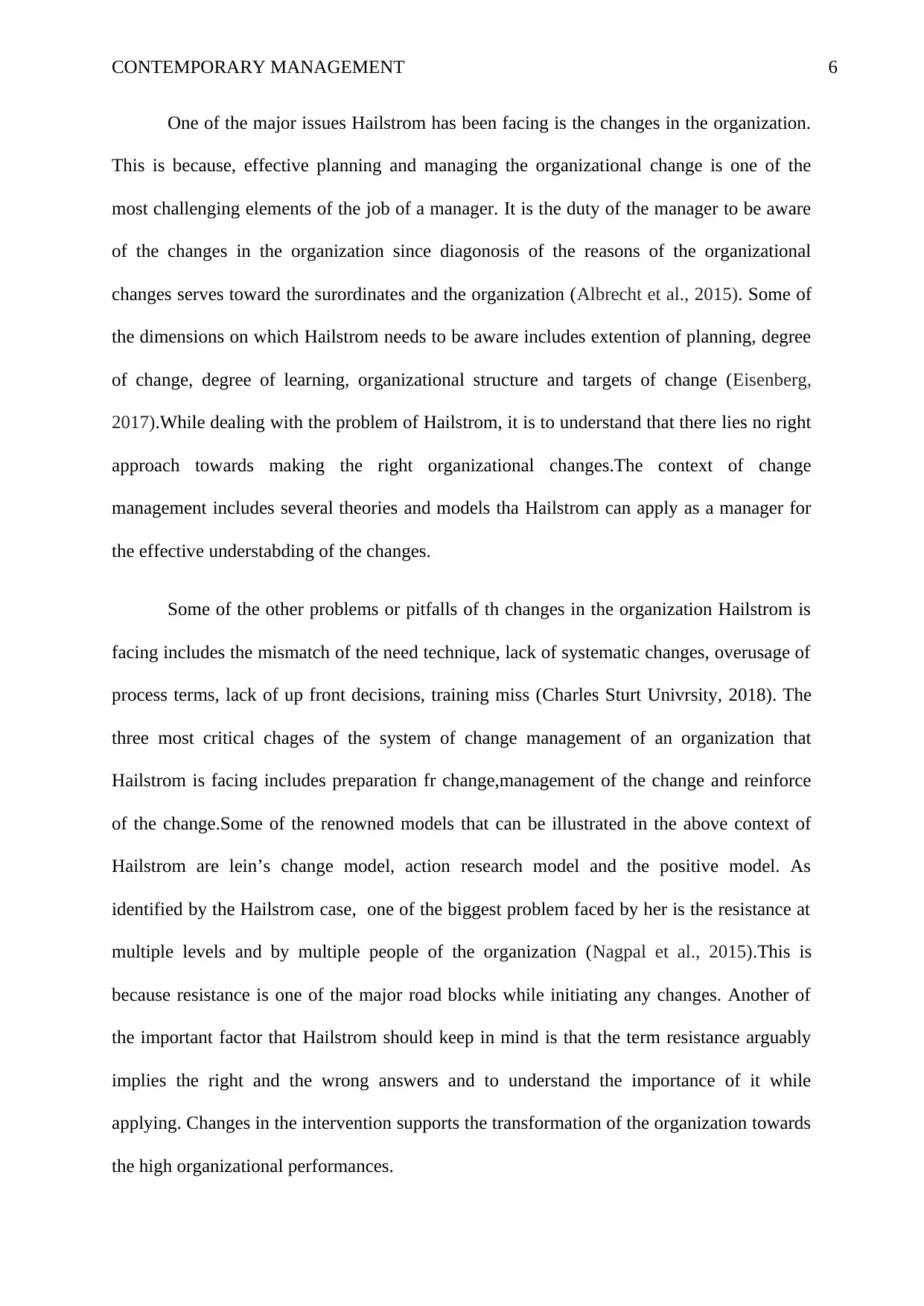
CONTEMPORARY MANAGEMENT 6
One of the major issues Hailstrom has been facing is the changes in the organization.
This is because, effective planning and managing the organizational change is one of the
most challenging elements of the job of a manager. It is the duty of the manager to be aware
of the changes in the organization since diagonosis of the reasons of the organizational
changes serves toward the surordinates and the organization (Albrecht et al., 2015). Some of
the dimensions on which Hailstrom needs to be aware includes extention of planning, degree
of change, degree of learning, organizational structure and targets of change (Eisenberg,
2017).While dealing with the problem of Hailstrom, it is to understand that there lies no right
approach towards making the right organizational changes.The context of change
management includes several theories and models tha Hailstrom can apply as a manager for
the effective understabding of the changes.
Some of the other problems or pitfalls of th changes in the organization Hailstrom is
facing includes the mismatch of the need technique, lack of systematic changes, overusage of
process terms, lack of up front decisions, training miss (Charles Sturt Univrsity, 2018). The
three most critical chages of the system of change management of an organization that
Hailstrom is facing includes preparation fr change,management of the change and reinforce
of the change.Some of the renowned models that can be illustrated in the above context of
Hailstrom are lein’s change model, action research model and the positive model. As
identified by the Hailstrom case, one of the biggest problem faced by her is the resistance at
multiple levels and by multiple people of the organization (Nagpal et al., 2015).This is
because resistance is one of the major road blocks while initiating any changes. Another of
the important factor that Hailstrom should keep in mind is that the term resistance arguably
implies the right and the wrong answers and to understand the importance of it while
applying. Changes in the intervention supports the transformation of the organization towards
the high organizational performances.
One of the major issues Hailstrom has been facing is the changes in the organization.
This is because, effective planning and managing the organizational change is one of the
most challenging elements of the job of a manager. It is the duty of the manager to be aware
of the changes in the organization since diagonosis of the reasons of the organizational
changes serves toward the surordinates and the organization (Albrecht et al., 2015). Some of
the dimensions on which Hailstrom needs to be aware includes extention of planning, degree
of change, degree of learning, organizational structure and targets of change (Eisenberg,
2017).While dealing with the problem of Hailstrom, it is to understand that there lies no right
approach towards making the right organizational changes.The context of change
management includes several theories and models tha Hailstrom can apply as a manager for
the effective understabding of the changes.
Some of the other problems or pitfalls of th changes in the organization Hailstrom is
facing includes the mismatch of the need technique, lack of systematic changes, overusage of
process terms, lack of up front decisions, training miss (Charles Sturt Univrsity, 2018). The
three most critical chages of the system of change management of an organization that
Hailstrom is facing includes preparation fr change,management of the change and reinforce
of the change.Some of the renowned models that can be illustrated in the above context of
Hailstrom are lein’s change model, action research model and the positive model. As
identified by the Hailstrom case, one of the biggest problem faced by her is the resistance at
multiple levels and by multiple people of the organization (Nagpal et al., 2015).This is
because resistance is one of the major road blocks while initiating any changes. Another of
the important factor that Hailstrom should keep in mind is that the term resistance arguably
implies the right and the wrong answers and to understand the importance of it while
applying. Changes in the intervention supports the transformation of the organization towards
the high organizational performances.
Paraphrase This Document
Need a fresh take? Get an instant paraphrase of this document with our AI Paraphraser
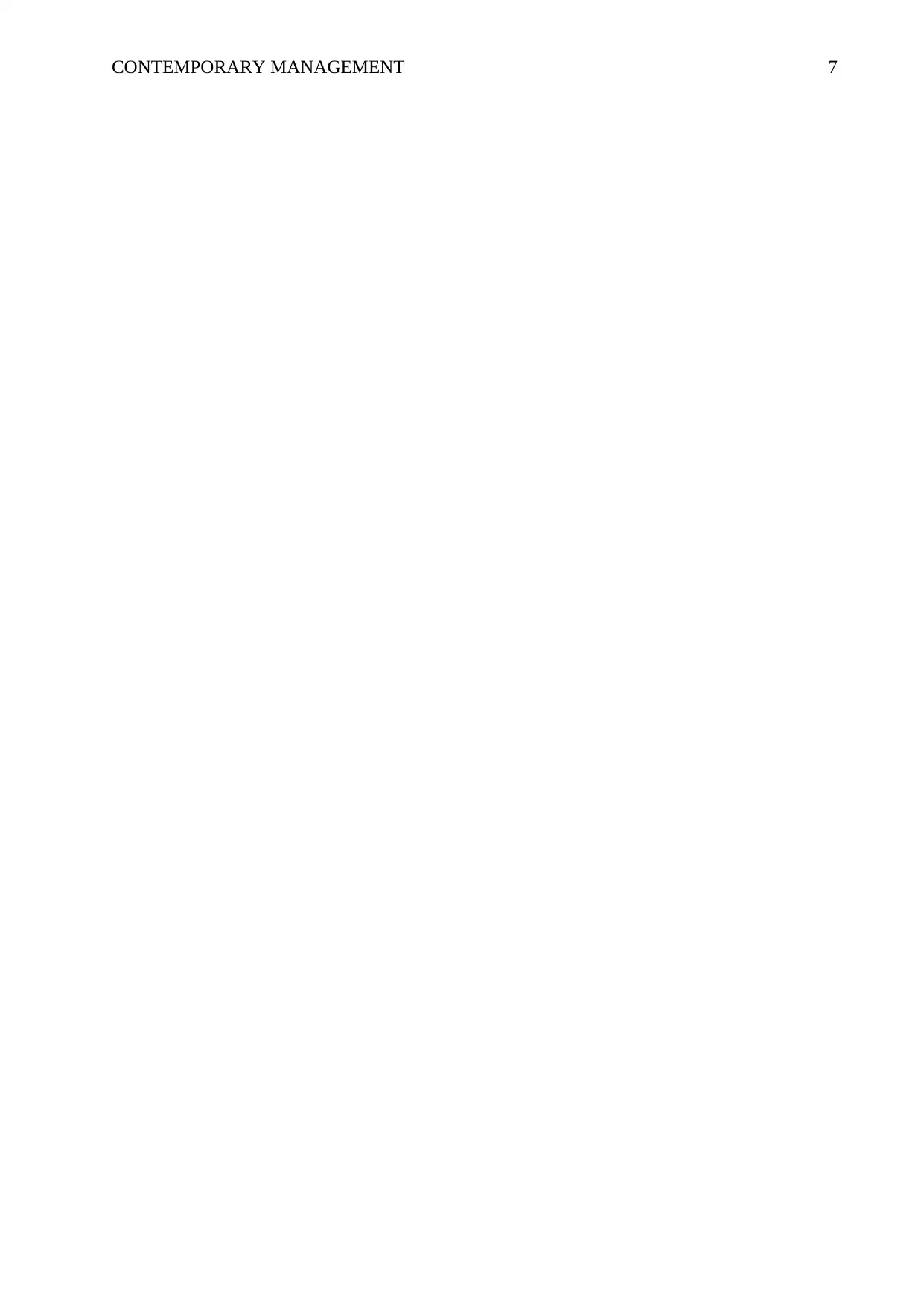
CONTEMPORARY MANAGEMENT 7
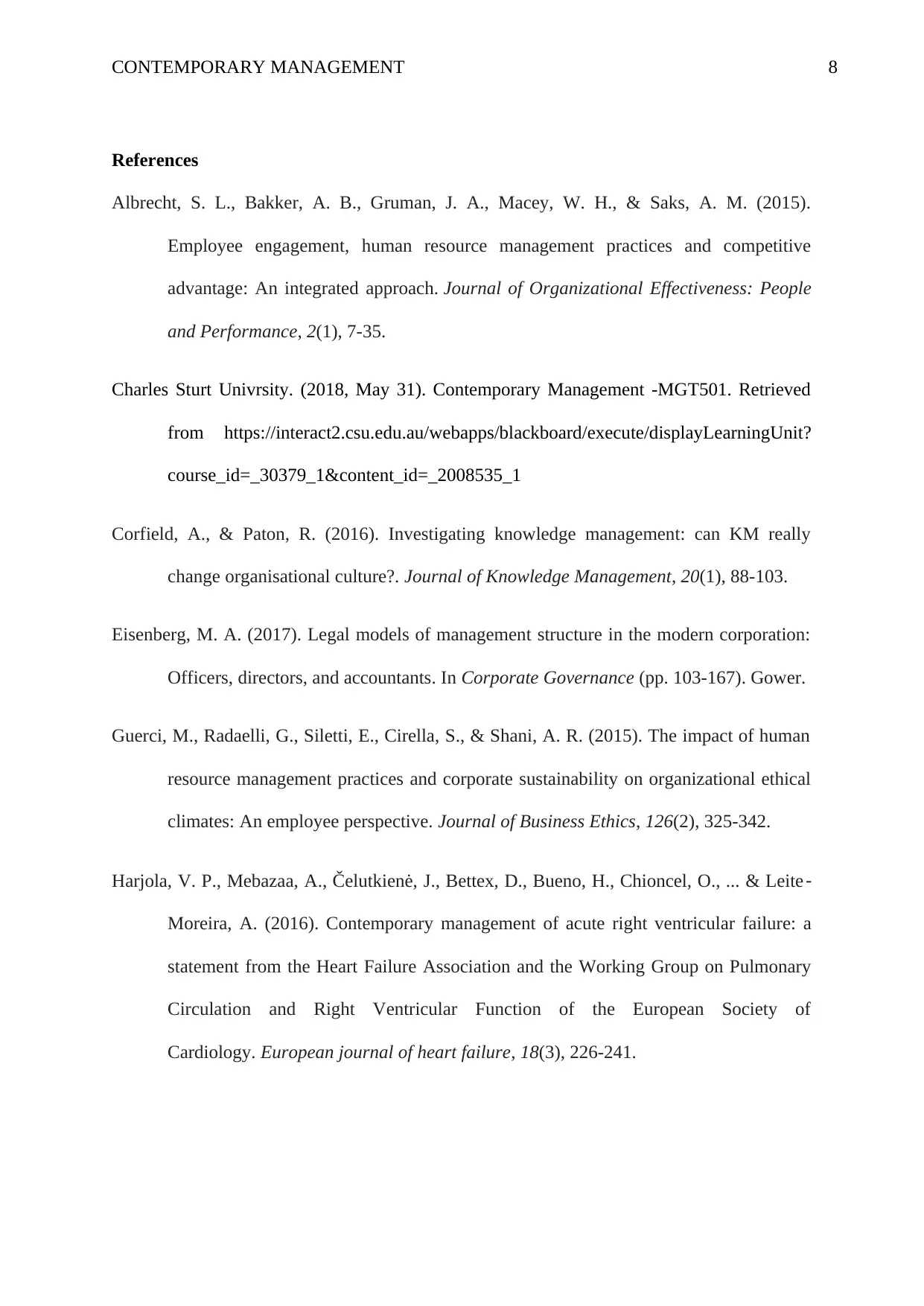
CONTEMPORARY MANAGEMENT 8
References
Albrecht, S. L., Bakker, A. B., Gruman, J. A., Macey, W. H., & Saks, A. M. (2015).
Employee engagement, human resource management practices and competitive
advantage: An integrated approach. Journal of Organizational Effectiveness: People
and Performance, 2(1), 7-35.
Charles Sturt Univrsity. (2018, May 31). Contemporary Management -MGT501. Retrieved
from https://interact2.csu.edu.au/webapps/blackboard/execute/displayLearningUnit?
course_id=_30379_1&content_id=_2008535_1
Corfield, A., & Paton, R. (2016). Investigating knowledge management: can KM really
change organisational culture?. Journal of Knowledge Management, 20(1), 88-103.
Eisenberg, M. A. (2017). Legal models of management structure in the modern corporation:
Officers, directors, and accountants. In Corporate Governance (pp. 103-167). Gower.
Guerci, M., Radaelli, G., Siletti, E., Cirella, S., & Shani, A. R. (2015). The impact of human
resource management practices and corporate sustainability on organizational ethical
climates: An employee perspective. Journal of Business Ethics, 126(2), 325-342.
Harjola, V. P., Mebazaa, A., Čelutkienė, J., Bettex, D., Bueno, H., Chioncel, O., ... & Leite ‐
Moreira, A. (2016). Contemporary management of acute right ventricular failure: a
statement from the Heart Failure Association and the Working Group on Pulmonary
Circulation and Right Ventricular Function of the European Society of
Cardiology. European journal of heart failure, 18(3), 226-241.
References
Albrecht, S. L., Bakker, A. B., Gruman, J. A., Macey, W. H., & Saks, A. M. (2015).
Employee engagement, human resource management practices and competitive
advantage: An integrated approach. Journal of Organizational Effectiveness: People
and Performance, 2(1), 7-35.
Charles Sturt Univrsity. (2018, May 31). Contemporary Management -MGT501. Retrieved
from https://interact2.csu.edu.au/webapps/blackboard/execute/displayLearningUnit?
course_id=_30379_1&content_id=_2008535_1
Corfield, A., & Paton, R. (2016). Investigating knowledge management: can KM really
change organisational culture?. Journal of Knowledge Management, 20(1), 88-103.
Eisenberg, M. A. (2017). Legal models of management structure in the modern corporation:
Officers, directors, and accountants. In Corporate Governance (pp. 103-167). Gower.
Guerci, M., Radaelli, G., Siletti, E., Cirella, S., & Shani, A. R. (2015). The impact of human
resource management practices and corporate sustainability on organizational ethical
climates: An employee perspective. Journal of Business Ethics, 126(2), 325-342.
Harjola, V. P., Mebazaa, A., Čelutkienė, J., Bettex, D., Bueno, H., Chioncel, O., ... & Leite ‐
Moreira, A. (2016). Contemporary management of acute right ventricular failure: a
statement from the Heart Failure Association and the Working Group on Pulmonary
Circulation and Right Ventricular Function of the European Society of
Cardiology. European journal of heart failure, 18(3), 226-241.
⊘ This is a preview!⊘
Do you want full access?
Subscribe today to unlock all pages.

Trusted by 1+ million students worldwide
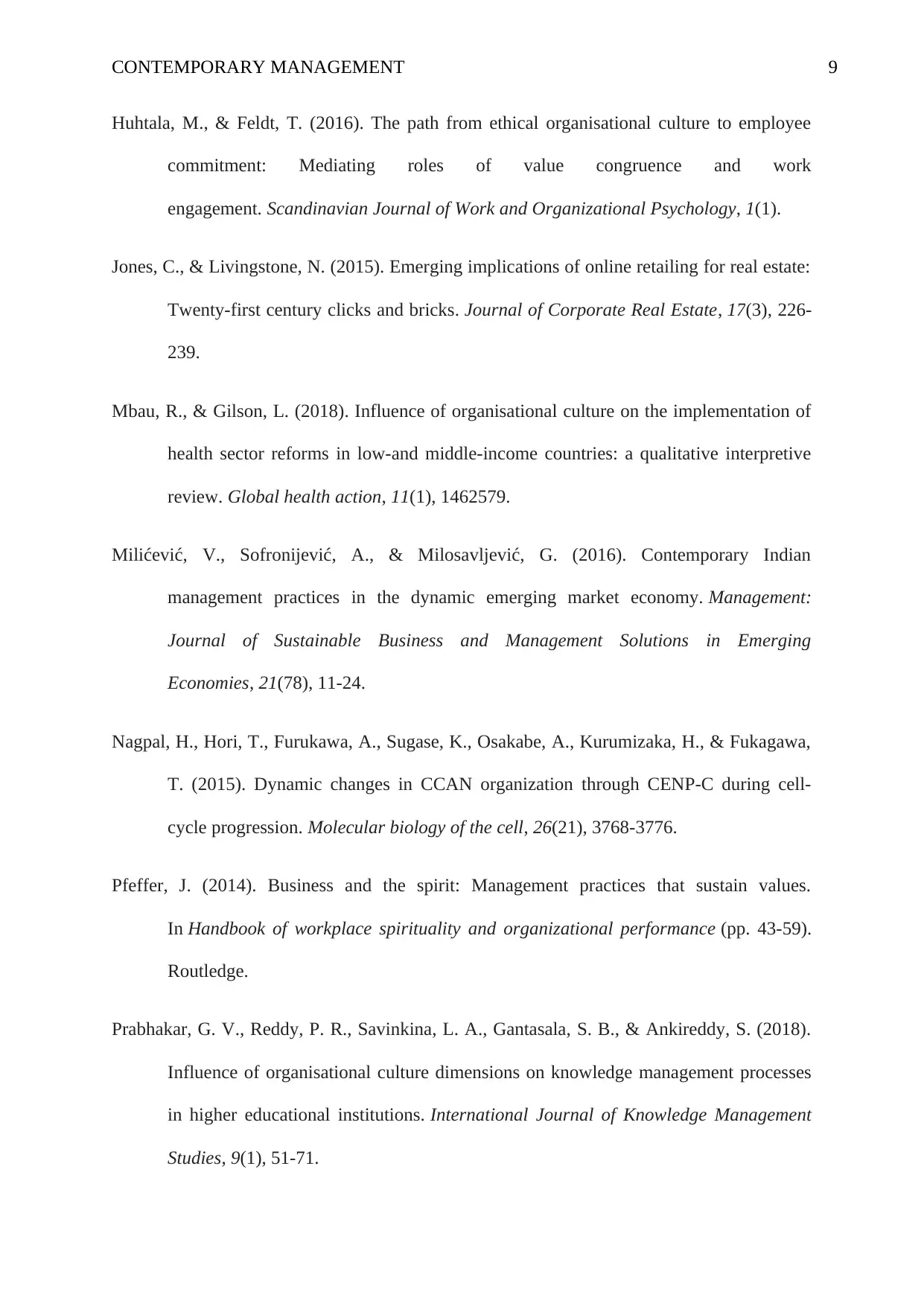
CONTEMPORARY MANAGEMENT 9
Huhtala, M., & Feldt, T. (2016). The path from ethical organisational culture to employee
commitment: Mediating roles of value congruence and work
engagement. Scandinavian Journal of Work and Organizational Psychology, 1(1).
Jones, C., & Livingstone, N. (2015). Emerging implications of online retailing for real estate:
Twenty-first century clicks and bricks. Journal of Corporate Real Estate, 17(3), 226-
239.
Mbau, R., & Gilson, L. (2018). Influence of organisational culture on the implementation of
health sector reforms in low-and middle-income countries: a qualitative interpretive
review. Global health action, 11(1), 1462579.
Milićević, V., Sofronijević, A., & Milosavljević, G. (2016). Contemporary Indian
management practices in the dynamic emerging market economy. Management:
Journal of Sustainable Business and Management Solutions in Emerging
Economies, 21(78), 11-24.
Nagpal, H., Hori, T., Furukawa, A., Sugase, K., Osakabe, A., Kurumizaka, H., & Fukagawa,
T. (2015). Dynamic changes in CCAN organization through CENP-C during cell-
cycle progression. Molecular biology of the cell, 26(21), 3768-3776.
Pfeffer, J. (2014). Business and the spirit: Management practices that sustain values.
In Handbook of workplace spirituality and organizational performance (pp. 43-59).
Routledge.
Prabhakar, G. V., Reddy, P. R., Savinkina, L. A., Gantasala, S. B., & Ankireddy, S. (2018).
Influence of organisational culture dimensions on knowledge management processes
in higher educational institutions. International Journal of Knowledge Management
Studies, 9(1), 51-71.
Huhtala, M., & Feldt, T. (2016). The path from ethical organisational culture to employee
commitment: Mediating roles of value congruence and work
engagement. Scandinavian Journal of Work and Organizational Psychology, 1(1).
Jones, C., & Livingstone, N. (2015). Emerging implications of online retailing for real estate:
Twenty-first century clicks and bricks. Journal of Corporate Real Estate, 17(3), 226-
239.
Mbau, R., & Gilson, L. (2018). Influence of organisational culture on the implementation of
health sector reforms in low-and middle-income countries: a qualitative interpretive
review. Global health action, 11(1), 1462579.
Milićević, V., Sofronijević, A., & Milosavljević, G. (2016). Contemporary Indian
management practices in the dynamic emerging market economy. Management:
Journal of Sustainable Business and Management Solutions in Emerging
Economies, 21(78), 11-24.
Nagpal, H., Hori, T., Furukawa, A., Sugase, K., Osakabe, A., Kurumizaka, H., & Fukagawa,
T. (2015). Dynamic changes in CCAN organization through CENP-C during cell-
cycle progression. Molecular biology of the cell, 26(21), 3768-3776.
Pfeffer, J. (2014). Business and the spirit: Management practices that sustain values.
In Handbook of workplace spirituality and organizational performance (pp. 43-59).
Routledge.
Prabhakar, G. V., Reddy, P. R., Savinkina, L. A., Gantasala, S. B., & Ankireddy, S. (2018).
Influence of organisational culture dimensions on knowledge management processes
in higher educational institutions. International Journal of Knowledge Management
Studies, 9(1), 51-71.
Paraphrase This Document
Need a fresh take? Get an instant paraphrase of this document with our AI Paraphraser
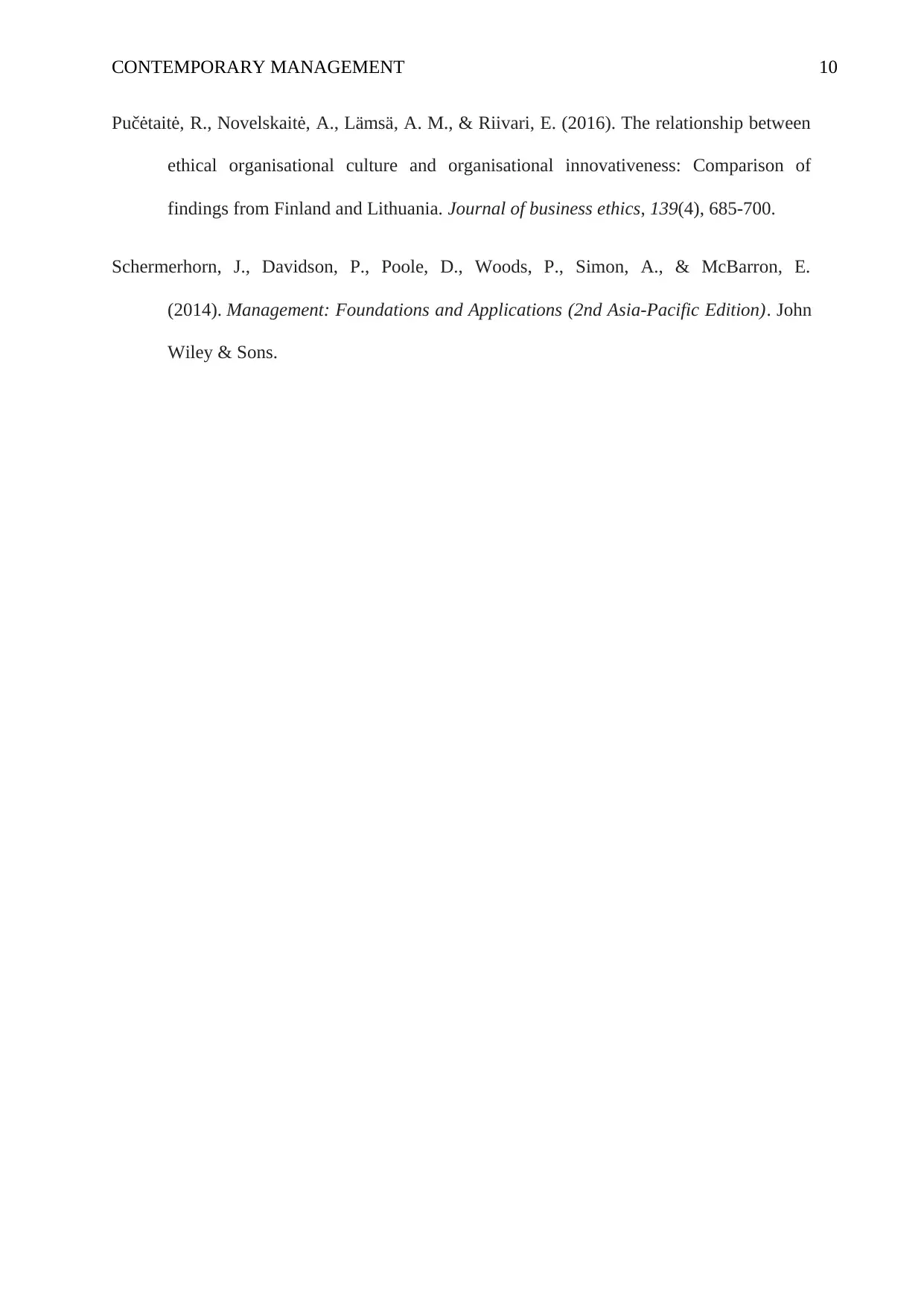
CONTEMPORARY MANAGEMENT 10
Pučėtaitė, R., Novelskaitė, A., Lämsä, A. M., & Riivari, E. (2016). The relationship between
ethical organisational culture and organisational innovativeness: Comparison of
findings from Finland and Lithuania. Journal of business ethics, 139(4), 685-700.
Schermerhorn, J., Davidson, P., Poole, D., Woods, P., Simon, A., & McBarron, E.
(2014). Management: Foundations and Applications (2nd Asia-Pacific Edition). John
Wiley & Sons.
Pučėtaitė, R., Novelskaitė, A., Lämsä, A. M., & Riivari, E. (2016). The relationship between
ethical organisational culture and organisational innovativeness: Comparison of
findings from Finland and Lithuania. Journal of business ethics, 139(4), 685-700.
Schermerhorn, J., Davidson, P., Poole, D., Woods, P., Simon, A., & McBarron, E.
(2014). Management: Foundations and Applications (2nd Asia-Pacific Edition). John
Wiley & Sons.
1 out of 11
Related Documents
Your All-in-One AI-Powered Toolkit for Academic Success.
+13062052269
info@desklib.com
Available 24*7 on WhatsApp / Email
![[object Object]](/_next/static/media/star-bottom.7253800d.svg)
Unlock your academic potential
Copyright © 2020–2025 A2Z Services. All Rights Reserved. Developed and managed by ZUCOL.





